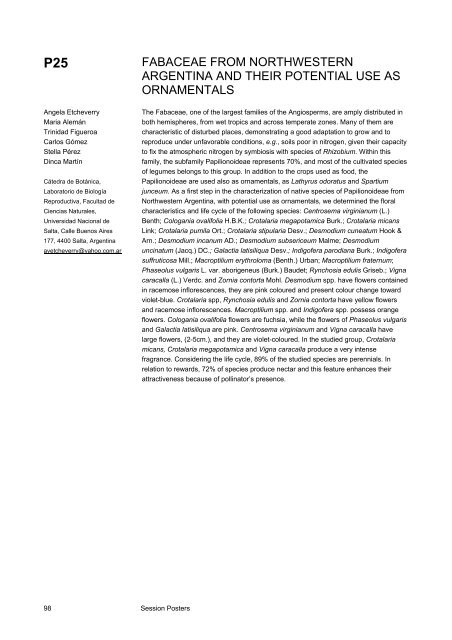XXIIIrd International Eucarpia symposium, Section Ornamentals ...
XXIIIrd International Eucarpia symposium, Section Ornamentals ...
XXIIIrd International Eucarpia symposium, Section Ornamentals ...
Create successful ePaper yourself
Turn your PDF publications into a flip-book with our unique Google optimized e-Paper software.
P25<br />
Angela Etcheverry<br />
Maria Alemán<br />
Trinidad Figueroa<br />
Carlos Gómez<br />
Stella Pérez<br />
Dinca Martín<br />
Cátedra de Botánica,<br />
Laboratorio de Biología<br />
Reproductiva, Facultad de<br />
Ciencias Naturales,<br />
Universidad Nacional de<br />
Salta, Calle Buenos Aires<br />
177, 4400 Salta, Argentina<br />
avetcheverry@yahoo.com.ar<br />
FABACEAE FROM NORTHWESTERN<br />
ARGENTINA AND THEIR POTENTIAL USE AS<br />
ORNAMENTALS<br />
The Fabaceae, one of the largest families of the Angiosperms, are amply distributed in<br />
both hemispheres, from wet tropics and across temperate zones. Many of them are<br />
characteristic of disturbed places, demonstrating a good adaptation to grow and to<br />
reproduce under unfavorable conditions, e.g., soils poor in nitrogen, given their capacity<br />
to fix the atmospheric nitrogen by symbiosis with species of Rhizobium. Within this<br />
family, the subfamily Papilionoideae represents 70%, and most of the cultivated species<br />
of legumes belongs to this group. In addition to the crops used as food, the<br />
Papilionoideae are used also as ornamentals, as Lathyrus odoratus and Spartium<br />
junceum. As a first step in the characterization of native species of Papilionoideae from<br />
Northwestern Argentina, with potential use as ornamentals, we determined the floral<br />
characteristics and life cycle of the following species: Centrosema virginianum (L.)<br />
Benth; Cologania ovalifolia H.B.K.; Crotalaria megapotamica Burk.; Crotalaria micans<br />
Link; Crotalaria pumila Ort.; Crotalaria stipularia Desv.; Desmodium cuneatum Hook &<br />
Arn.; Desmodium incanum AD.; Desmodium subsericeum Malme; Desmodium<br />
uncinatum (Jacq.) DC.; Galactia latisiliqua Desv.; Indigofera parodiana Burk.; Indigofera<br />
suffruticosa Mill.; Macroptilium erythroloma (Benth.) Urban; Macroptilium fraternum;<br />
Phaseolus vulgaris L. var. aborigeneus (Burk.) Baudet; Rynchosia edulis Griseb.; Vigna<br />
caracalla (L.) Verdc. and Zornia contorta Mohl. Desmodium spp. have flowers contained<br />
in racemose inflorescences, they are pink coloured and present colour change toward<br />
violet-blue. Crotalaria spp, Rynchosia edulis and Zornia contorta have yellow flowers<br />
and racemose inflorescences. Macroptilium spp. and Indigofera spp. possess orange<br />
flowers. Cologania ovalifolia flowers are fuchsia, while the flowers of Phaseolus vulgaris<br />
and Galactia latisiliqua are pink. Centrosema virginianum and Vigna caracalla have<br />
large flowers, (2-5cm.), and they are violet-coloured. In the studied group, Crotalaria<br />
micans, Crotalaria megapotamica and Vigna caracalla produce a very intense<br />
fragrance. Considering the life cycle, 89% of the studied species are perennials. In<br />
relation to rewards, 72% of species produce nectar and this feature enhances their<br />
attractiveness because of pollinator’s presence.<br />
98 Session Posters














